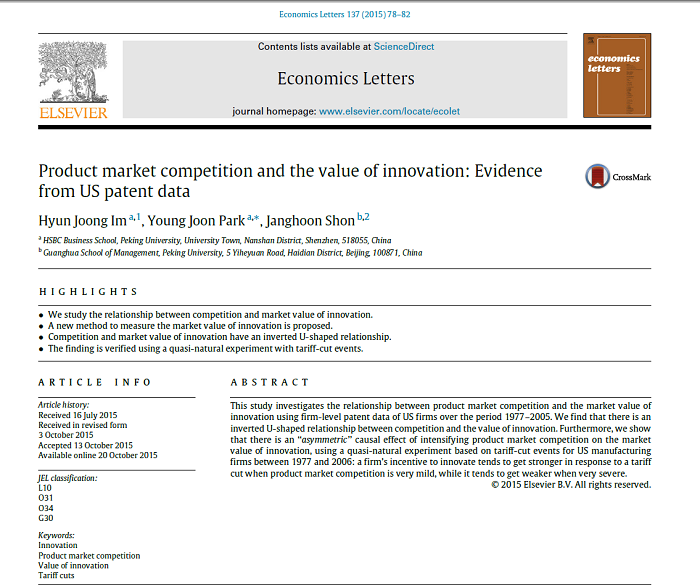The international academic publication,
Economic Letters, has published research co-authored by two Peking University HSBC Business School (PHBS) faculty members. “Product market competition and the value of innovation: Evidence from US patent data,” by PHBS assistant professors Hyun Joon Im and Young Joon Park and Janghoon Shon from Guanghua School of Management, Peking University, analyzes firm-level patent data of US firms between 1977-2005and finds that competition and market value of innovation have an inverted U-shaped relationship.


Hyun Joong Im, Young Joon Park, Janghoon Shon, “Product market competition and the value of innovation: Evidence from US patent data,” Economic Letters, Volume 137, December 2015, Pages 78–82.
According to the authors, scholars have studied the relationship between product market competition and innovation over past decades, yet theoretical predictions and empirical findings do not reach consensus, calling for further investigation on the topic.
Unlike most existing studies on the relationship between product market competition and innovation, the authors directly measure the market value of innovation to judge how a firm’s incentive to innovate changes through different levels of product market competition. Innovation is measured by using the number of total non-self citations of the patents that a firm has applied for in a specific year. Industry-level product market competition is measured by using price-cost margin (also known as Lerner Index).
How does the market value of innovation vary with the intensity of product market competition? The authors modify an existing framework and investigate the effect of a competition measure on the coefficient of an innovation measure in a regression model in which the dependent variable is excess or raw stock returns of firms. They also include industry dummies based on Fama and French’s 12 industries and year dummies to control for industry and year fixed effects.
With analysis of the regression model, they find that there exists a significant non-linear relationship between the value of innovation and competition. The market value of innovation and the product market competition have an inverted U-shaped relationship.
According to the authors, a quasi-natural experiment using tariff cuts is designed to mitigate three potential concerns of the main regression model: reverse causality, simultaneity bias, and price-cost margin not being the best measure. They examine the impact of an exogenous shock to competition on the value of innovation and the impact of tariff events on the value of innovation. Defined by the authors, a tariff cut “is considered a positive shock to the competition of the corresponding industry because it lowers foreign firms’ entry barriers, intensifying product market competition.” They reveal an ‘‘asymmetric’’ causal effect of intensifying product market competition on the market value of innovation (concerning a tariff-cut shock, incentive to innovate tends to get stronger when the market is not very competitive, and weaker when the market is too competitive). The authors also carry out robustness tests of their major findings, resulting in positive results.
Although some past studies also find an inverted U-shaped relationship between competition and the value of innovation, Im and Park’s research can be interpreted differently as the authors directly measure the market value of innovation while past studies measure the magnitude of innovation. Yet the authors also point out that it cannot be concluded that increased innovation is necessarily due to the increased market value of innovation. The findings of the research also provide a piece of new evidence that innovation is driven by a similar inverted U-shaped relationship between competition and the market value of innovation.
By Sheryl Shao
Edited by Priscilla Young


For the research paper, click read more


















